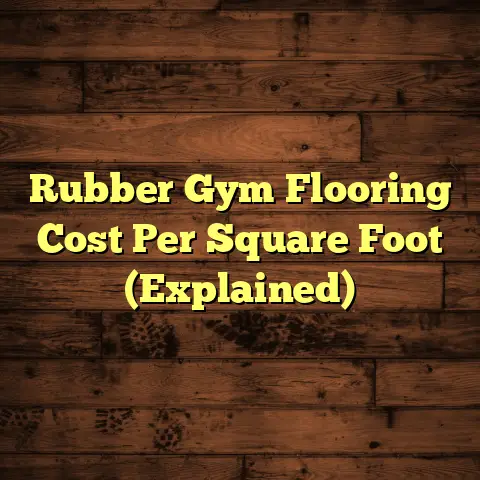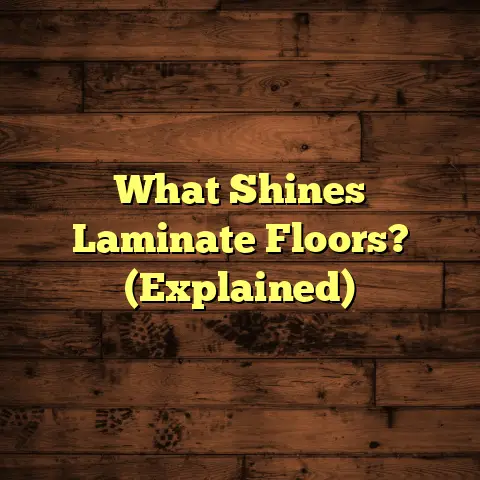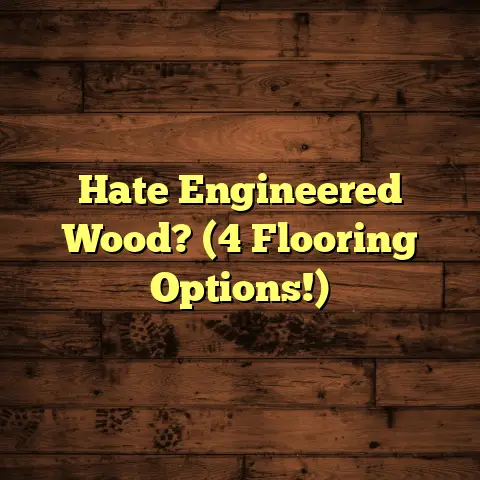Can Subfloor Be Your Actual Floor? (5 Fails Exposed!)
1. Understanding Subfloors
So, what is a subfloor, anyway? Think of it as the unsung hero beneath your feet. It’s the foundational layer that provides a smooth, level surface for your finished flooring – whether that’s hardwood, tile, carpet, or anything in between.
Its primary functions are to:
-
Provide Structural Support: It distributes weight evenly across the floor joists.
-
Create a Flat Surface: This is essential for a level, stable finished floor.
-
Offer a Nailable or Screwable Base: Allows for secure attachment of the finished floor.
Common materials you’ll find in subfloors include:
-
Plywood: A popular choice due to its strength and affordability.
-
OSB (Oriented Strand Board): Another cost-effective option, made from compressed wood strands.
-
Concrete: Typically used in basements or as a base for tile in bathrooms and kitchens.
Why is a stable subfloor so crucial? Well, imagine building a house on a shaky foundation. It’s a recipe for disaster, right? The same goes for your flooring. A solid subfloor ensures your finished floor lasts longer, looks better, and feels more comfortable underfoot.
2. The Allure of Using Subfloor as Finished Flooring
Okay, let’s address the elephant in the room. Why would anyone want to use their subfloor as the finished floor? There are a few reasons:
-
Aesthetic Trends: The rise of industrial and minimalist design has made raw, unfinished looks more appealing. Think exposed brick, concrete walls, and… well, subfloors.
-
Cost Savings: Let’s be honest, flooring can be expensive! Skipping the finished floor can save you a significant chunk of change.
-
DIY Appeal: For the adventurous DIYer, the idea of staining, painting, or sealing a subfloor can be an exciting project.
I’ve seen some pretty cool subfloor transformations online. People are staining them, adding epoxy coatings, and even creating faux concrete looks. But are these trendy makeovers really a good idea in the long run? Let’s find out.
3. Fail #1: Structural Integrity Compromised
Here’s the cold, hard truth: subfloors aren’t designed for foot traffic. They’re built to support the finished floor, not be the finished floor.
Think about it this way: your subfloor is like the understudy in a play. It’s there in case something goes wrong, but it’s not meant to be the star.
Plywood and OSB, the most common subfloor materials, lack the density and durability of hardwood, tile, or even laminate flooring. Over time, foot traffic can lead to:
-
Sagging: Especially in areas with heavy use.
-
Warping: Due to moisture exposure or uneven support.
-
Cracking: From impact or stress.
I’ve seen firsthand how quickly a subfloor can deteriorate when exposed to everyday wear and tear. A client of mine decided to use their OSB subfloor as a temporary solution while they saved up for hardwood. Within six months, it was a mess of dents, scratches, and splintered edges. Not exactly the chic, industrial look they were going for!
According to the APA – The Engineered Wood Association, subfloor panels should be installed according to specific guidelines to ensure proper support and prevent issues like deflection (sagging). Ignoring these guidelines and using the subfloor as a finished surface only exacerbates these potential problems.
4. Fail #2: Aesthetic Shortcomings
Let’s be real: subfloors aren’t exactly known for their beauty. While some people might appreciate the raw, unfinished look, it often falls short of a polished, professional finish.
Here are some common aesthetic issues:
-
Unfinished Surfaces: Subfloors are typically rough and uneven, with visible seams and imperfections.
-
Exposed Nails and Staples: These can be unsightly and even dangerous.
-
Rough Textures: Not exactly comfortable to walk on barefoot.
-
Staining and Discoloration: Subfloors can easily stain from spills, dirt, and even the adhesives used during installation.
I remember one project where the homeowner tried to stain their plywood subfloor a dark walnut color. The result was… uneven, to say the least. The stain absorbed differently in different areas, creating a blotchy, inconsistent look. Plus, the exposed nail heads just looked… well, exposed.
While you can try to improve the appearance of a subfloor with sanding, staining, or sealing, it’s still unlikely to achieve the same level of visual appeal as a professionally installed finished floor. You’re essentially trying to turn a functional component into a decorative one, and the results are often underwhelming.
5. Fail #3: Moisture and Damage Risks
This is a big one. Subfloors are not designed to withstand moisture. Plywood and OSB are particularly vulnerable to water damage, which can lead to:
-
Mold and Mildew Growth: A health hazard, especially for those with allergies or respiratory issues.
-
Rotting and Decay: Weakening the structural integrity of the floor.
-
Swelling and Warping: Creating uneven surfaces and potential trip hazards.
I’ve seen countless cases where moisture issues have completely ruined subfloors. A leaky pipe, a spilled drink, or even high humidity can wreak havoc.
According to the EPA, mold can begin to grow on damp surfaces within 24 to 48 hours. That’s how quickly things can go south!
Concrete subfloors are less susceptible to water damage, but they can still absorb moisture, leading to efflorescence (a white, powdery deposit) and potential damage to any adhesives or coatings applied on top.
Using a subfloor as a finished floor without proper sealing and waterproofing is like leaving your house exposed to the elements. It’s only a matter of time before disaster strikes.
6. Fail #4: Noise and Comfort Concerns
Think about the satisfying “thud” of walking on a hardwood floor or the soft cushion of carpet under your feet. Subfloors offer neither of these.
Acoustically, subfloors tend to be noisy. Footsteps can echo and reverberate, especially in open-concept spaces. This is because subfloors lack the sound-dampening properties of finished flooring.
Comfort-wise, subfloors are often hard and unforgiving. Walking on a bare subfloor can be tiring and uncomfortable, especially for those with joint pain or foot problems.
I once visited a home where the owners had used their concrete subfloor as the finished floor. It looked cool, but it felt like walking on a slab of ice. It was cold, hard, and noisy. Not exactly a cozy and inviting atmosphere!
Adding rugs or mats can help mitigate some of these issues, but they’re not a complete solution. They can also detract from the minimalist aesthetic that many people are trying to achieve with a subfloor floor.
7. Fail #5: Resale Value Implications
Let’s talk about the elephant in the room: resale value. While you might love the look of your stained and sealed subfloor, potential buyers might not share your enthusiasm.
In most cases, using a subfloor as a finished floor will decrease your home’s resale value. Why? Because it can be perceived as:
-
Cheap and Unfinished: Giving the impression that you cut corners during renovations.
-
Low-Quality: Raising concerns about the durability and longevity of the flooring.
-
Outdated: Potentially clashing with the buyer’s aesthetic preferences.
I spoke with a local real estate agent, Sarah Miller, who confirmed this. “While some buyers might appreciate a unique, industrial look, the majority are looking for a move-in ready home with traditional flooring,” she said. “A subfloor floor can be a major turnoff and can definitely impact the perceived value of the property.”
Of course, there are exceptions. In certain markets or with the right buyer, a unique, well-executed subfloor floor might be a selling point. But in general, it’s a risky move that could cost you money in the long run.
8. Conclusion: The Final Verdict
So, can your subfloor be your actual floor? While the idea might seem appealing in terms of cost savings and aesthetic trends, the potential pitfalls far outweigh the benefits.
Subfloors are simply not designed to withstand the wear and tear of everyday life. They lack the structural integrity, aesthetic appeal, moisture resistance, comfort, and sound-dampening properties of finished flooring.
In the long run, investing in proper finished flooring is a much smarter choice. It will provide:
-
Durability: Lasting for years with proper care.
-
Aesthetics: Enhancing the overall look and feel of your home.
-
Comfort: Creating a more pleasant living environment.
-
Value: Increasing your home’s resale potential.
Don’t let the allure of a quick fix or a trendy look cloud your judgment. Choose flooring that will stand the test of time and add value to your home.
Call to Action:
What are your thoughts on flooring choices? Have you ever considered using your subfloor as your finished floor? Share your experiences and opinions in the comments below! And before making any flooring decisions, be sure to consult with a qualified flooring contractor to discuss your options and ensure a successful project. I’m always happy to help!





